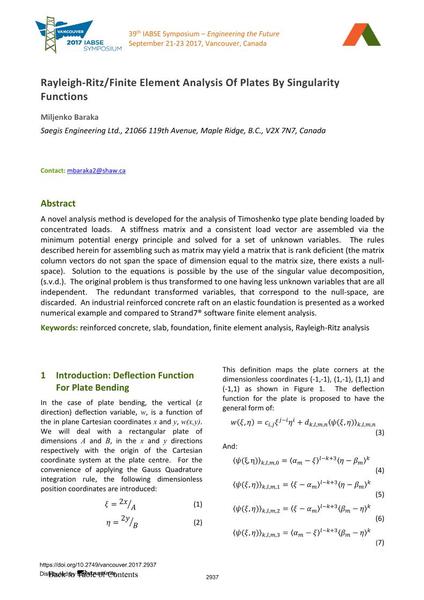Rayleigh-Ritz/Finite Element Analysis Of Plates By Singularity Functions

|
|
|||||||||||
Bibliographic Details
| Author(s): |
Miljenko Baraka
(Saegis Engineering Ltd., 21066 119th Avenue, Maple Ridge, B.C., V2X 7N7, Canada)
|
||||
|---|---|---|---|---|---|
| Medium: | conference paper | ||||
| Language(s): | English | ||||
| Conference: | IABSE Symposium: Engineering the Future, Vancouver, Canada, 21-23 September 2017 | ||||
| Published in: | IABSE Symposium Vancouver 2017 | ||||
|
|||||
| Page(s): | 2937-2949 | ||||
| Total no. of pages: | 13 | ||||
| Year: | 2017 | ||||
| DOI: | 10.2749/vancouver.2017.2937 | ||||
| Abstract: |
A novel analysis method is developed for the analysis of Timoshenko type plate bending loaded by concentrated loads. A stiffness matrix and a consistent load vector are assembled via the minimum potential energy principle and solved for a set of unknown variables. The rules described herein for assembling such as matrix may yield a matrix that is rank deficient (the matrix column vectors do not span the space of dimension equal to the matrix size, there exists a null- space). Solution to the equations is possible by the use of the singular value decomposition, (s.v.d.). The original problem is thus transformed to one having less unknown variables that are all independent. The redundant transformed variables, that correspond to the null-space, are discarded. An industrial reinforced concrete raft on an elastic foundation is presented as a worked numerical example and compared to Strand7® software finite element analysis. |
||||
| Keywords: |
finite element analysis FEA foundation reinforced concrete Rayleigh-Ritz analysis slab
|
||||
